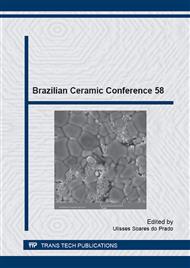p.443
p.449
p.455
p.462
p.468
p.474
p.483
p.488
p.492
Microstructural Analysis of Clayey Ceramics Incorporated with Fluorescent Lamp Glass Waste
Abstract:
The recycling of industrial wastes has become a worldwide practice owing to environmental and economical advantages. In the case of waste addition to clayey ceramics for civil construction, this sustainable practice may also bring technical benefits. Fluorescent lamps, today replacing incandescent lamps, generate typical glass waste that can improve the properties of clayey ceramics. The fluxing behavior of the glass waste contributes to the ceramic sintering mechanisms by reducing the porosity. In the present work, the effect of incorporation of 30 wt% of Hg-cleaned fluorescent lamps glass waste was investigated by means of microstructural analysis. Waste incorporated clayey ceramics, fired at 850 and 1100°C were analyzed by optical and scanning electron microscopy as well as by X-ray diffraction. The results revealed the microstructural mechanism responsible for the improvement of the ceramic properties.
Info:
Periodical:
Pages:
468-473
Citation:
Online since:
June 2015
Price:
Сopyright:
© 2015 Trans Tech Publications Ltd. All Rights Reserved
Share:
Citation:


